Abstract
1. In dogs anaesthetized with sodium pentobarbitone and artificially ventilated, the gracilis muscles were vascularly isolated and perfused at a constant flow rate of 51.2 +/- 9.8 ml min-1 100 g-1 muscle tissue (183 +/- 17.8% of resting blood flow; mean +/- S.E.; n = 13). 2. Electrical stimulation of the cut peripheral end of the obturator nerve (6 V, 4 Hz) resulted in muscle contraction (658 +/- 118 g 100 g-1 force after 5 min), and an immediate decrease in arterial perfusion pressure from 179 +/- 15.7 mmHg to 87 +/- 10.0 mmHg (51.4 +/- 4.5% decrease in vascular resistance after 2 min of contraction). Venous oxygen tension decreased from 69.2 +/- 5.1 mmHg to 18.5 +/- 1.4 mmHg (n = 6). These values did not significantly alter during the remaining period of stimulation (10-20 min). 3. The concentration of adenosine in arterial plasma did not change significantly during muscle contraction (137 +/- 23 nM; n = 10). However, the adenosine concentrations in venous plasma showed a significant (P less than 0.01) increase from a control value of 164 +/- 55 nM to 455 +/- 77 nM (n = 9) after 5 min of muscle contraction and remained high during the rest of the 20 min contraction. In six of the dogs adenosine concentrations were determined after 1 and 3 min of contraction and showed a smaller but statistically significant (P less than 0.05) rise in venous concentration. 4. During infusion of adenosine into the artery to give plasma concentrations between 0.3 microM and 1 mM, 72.6 +/- 2.1% (n = 29) of the infused adenosine was taken up by the tissues before it reached the vein. Comparison of vasodilatation and venous adenosine concentrations during adenosine infusion and muscle contractions showed that the released adenosine could contribute about 15% to the total vasodilatation after 1 min and about 40% between 5 and 20 min of contractions. Released adenosine could contribute about 80% to the vasodilatation that remained 5 min after the withdrawal of stimulation. Arterial perfusion pressure took 22 min to return to control, whereas adenosine release had fallen to zero within 10 min. 5. These data suggest that the released adenosine could contribute to exercise hyperaemia, but is unlikely to be the main factor, particularly in the initial stage.
Full text
PDF
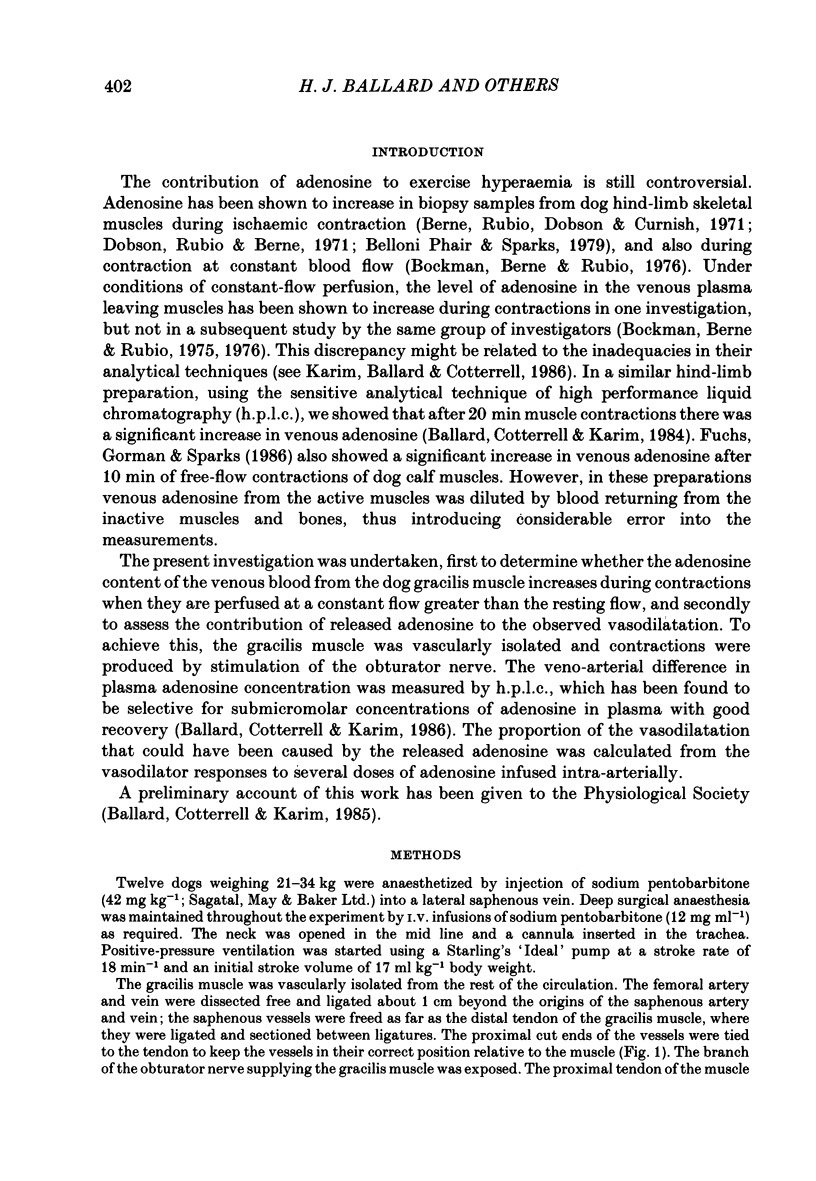


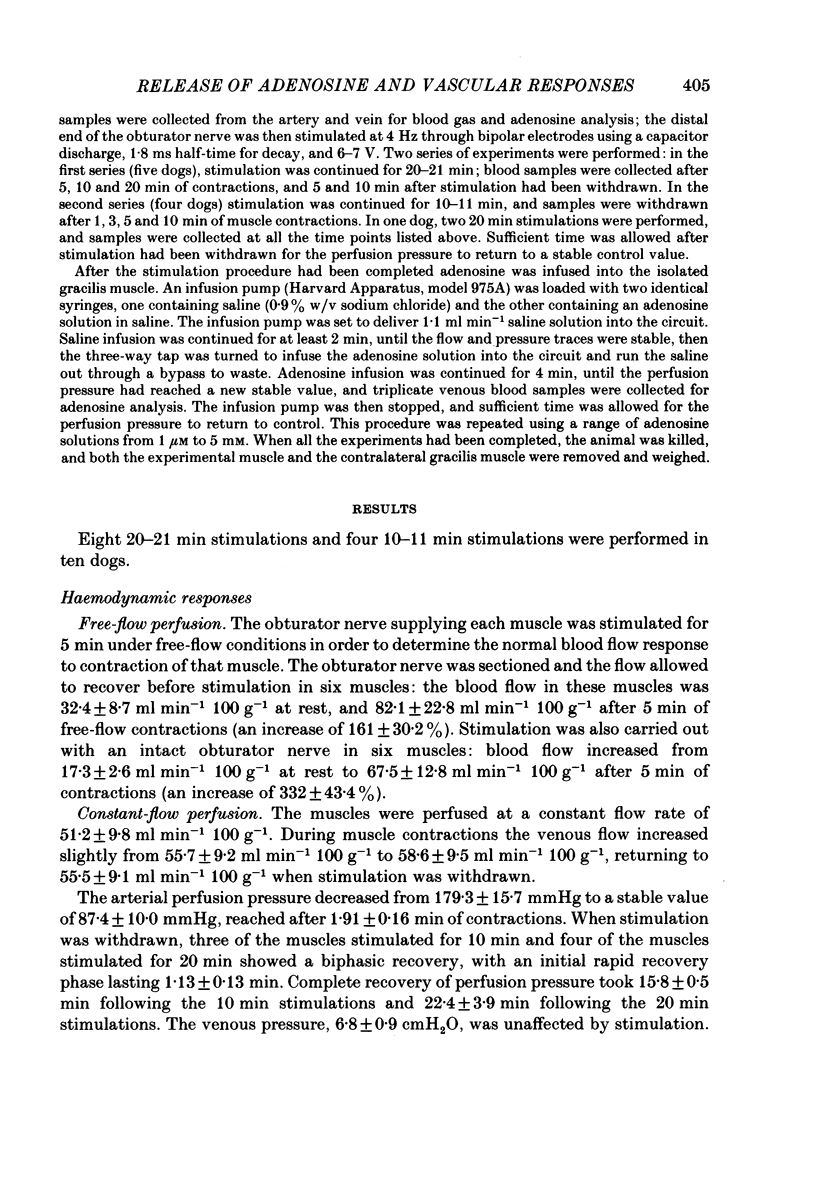




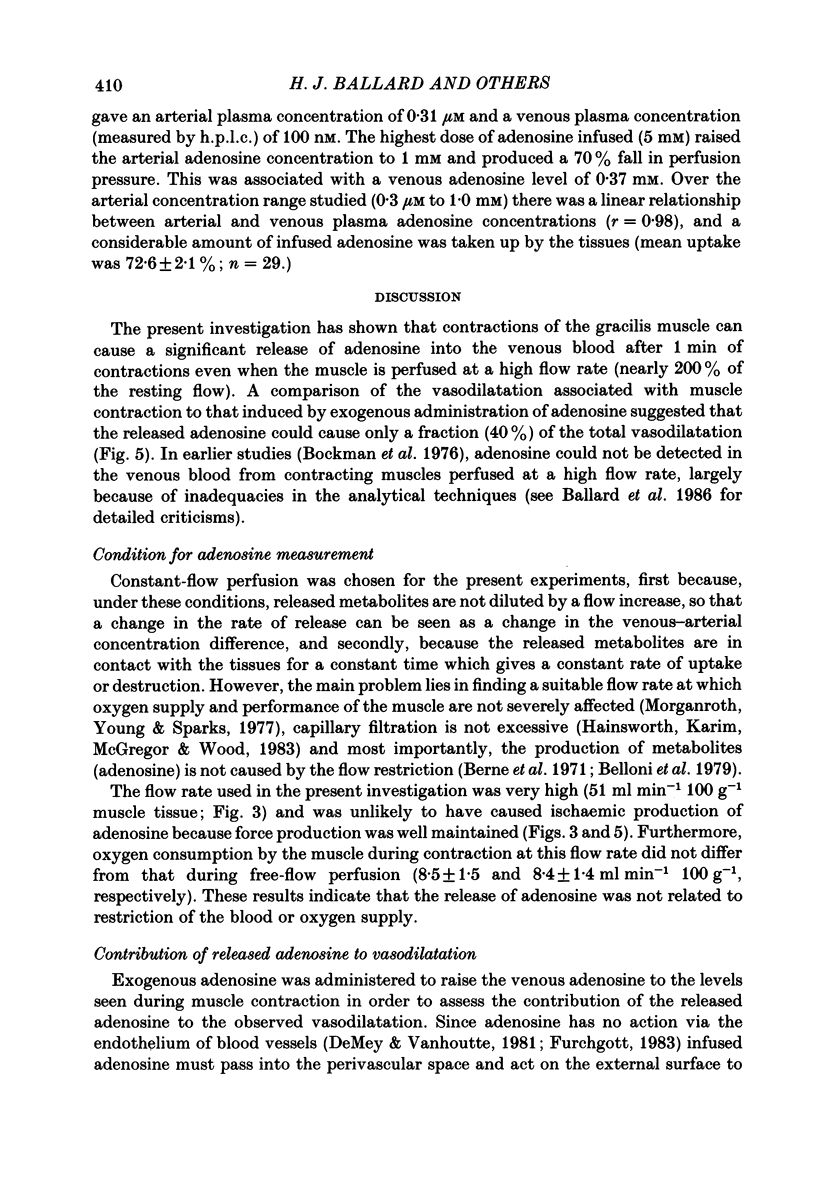
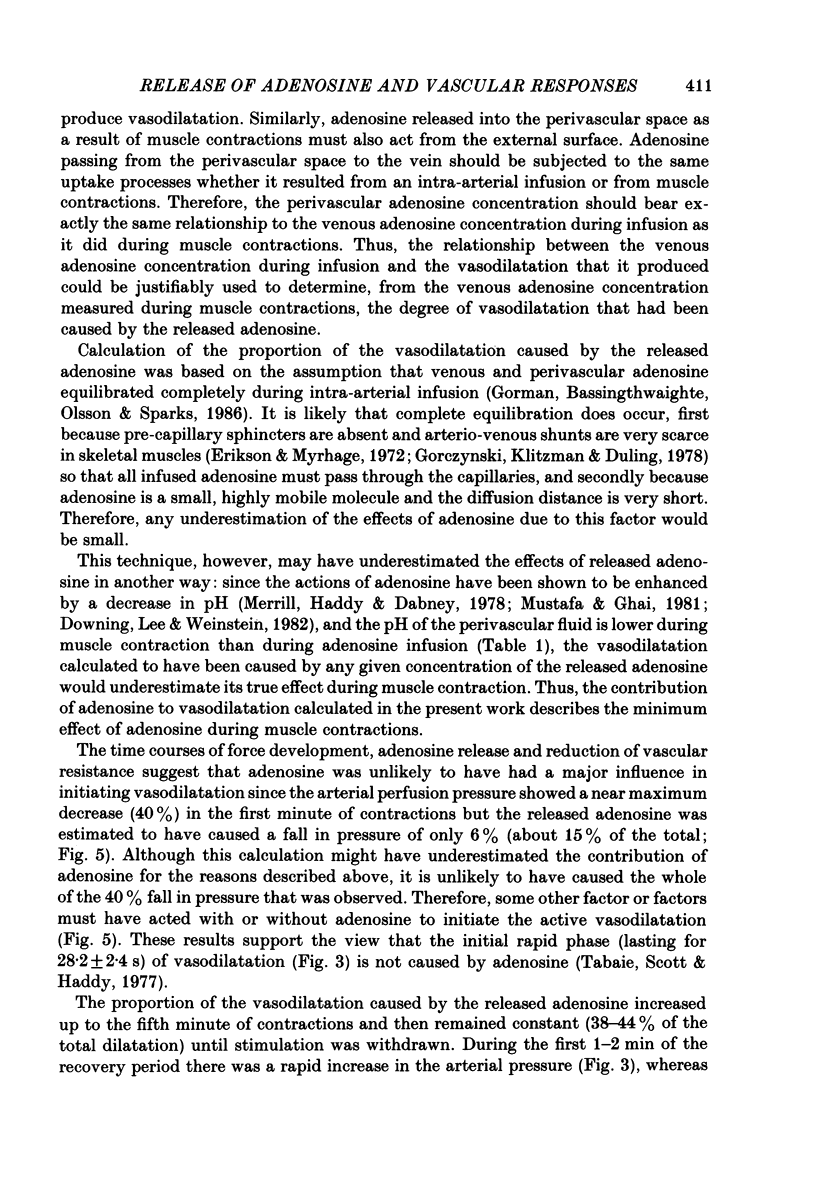

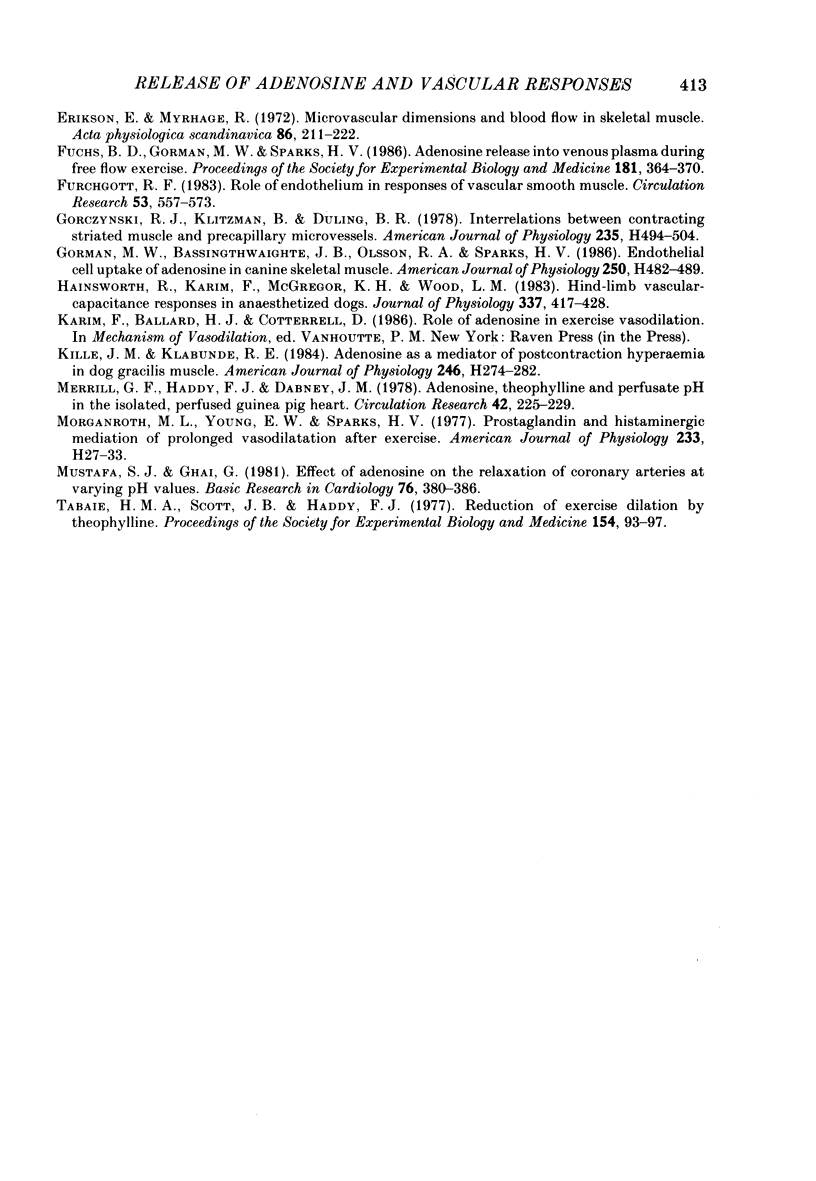
Selected References
These references are in PubMed. This may not be the complete list of references from this article.
- Ballard H. J., Cotterrell D., Karim F. Analysis of submicromolar concentrations of adenosine in plasma using reversed phase high-performance liquid chromatography. J Pharm Biomed Anal. 1986;4(2):207–219. doi: 10.1016/0731-7085(86)80043-7. [DOI] [PubMed] [Google Scholar]
- Belloni F. L., Phair R. D., Sparks H. V. The role of adenosine in prolonged vasodilation following flow-restricted exercise of canine skeletal muscle. Circ Res. 1979 Jun;44(6):759–766. doi: 10.1161/01.res.44.6.759. [DOI] [PubMed] [Google Scholar]
- Berne R. M., Rubio R., Dobson J. G., Jr, Curnish R. R. Adenosine and adenine nucleotides as possible mediators of cardiac and skeletal muscle blood flow regulation. Circ Res. 1971 Jan;28(Suppl):115+–115+. [PubMed] [Google Scholar]
- Bockman E. L., Berne R. M., Rubio R. Adenosine and active hyperemia in dog skeletal muscle. Am J Physiol. 1976 Jun;230(6):1531–1537. doi: 10.1152/ajplegacy.1976.230.6.1531. [DOI] [PubMed] [Google Scholar]
- Bockman E. L., Berne R. M., Rubio R. Release of adenosine and lack of release of ATP from contracting skeletal muscle. Pflugers Arch. 1975 Mar 26;355(3):229–241. doi: 10.1007/BF00583686. [DOI] [PubMed] [Google Scholar]
- De Mey J. G., Vanhoutte P. M. Role of the intima in cholinergic and purinergic relaxation of isolated canine femoral arteries. J Physiol. 1981 Jul;316:347–355. doi: 10.1113/jphysiol.1981.sp013792. [DOI] [PMC free article] [PubMed] [Google Scholar]
- Dobson J. G., Jr, Rubio R., Berne R. M. Role of adenine nucleotides, adenosine, and inorganic phosphate in the regulation of skeletal muscle blood flow. Circ Res. 1971 Oct;29(4):375–384. doi: 10.1161/01.res.29.4.375. [DOI] [PubMed] [Google Scholar]
- Downing S. E., Lee J. C., Weinstein E. M. Coronary dilator actions of adenosine and CO2 in experimental diabetes. Am J Physiol. 1982 Aug;243(2):H252–H258. doi: 10.1152/ajpheart.1982.243.2.H252. [DOI] [PubMed] [Google Scholar]
- Eriksson E., Myrhage R. Microvascular dimensions and blood flow in skeletal muscle. Acta Physiol Scand. 1972 Oct;86(2):211–222. doi: 10.1111/j.1748-1716.1972.tb05327.x. [DOI] [PubMed] [Google Scholar]
- Fuchs B. D., Gorman M. W., Sparks H. V. Adenosine release into venous plasma during free flow exercise. Proc Soc Exp Biol Med. 1986 Mar;181(3):364–370. doi: 10.3181/00379727-181-42266. [DOI] [PubMed] [Google Scholar]
- Furchgott R. F. Role of endothelium in responses of vascular smooth muscle. Circ Res. 1983 Nov;53(5):557–573. doi: 10.1161/01.res.53.5.557. [DOI] [PubMed] [Google Scholar]
- Gorczynski R. J., Klitzman B., Duling B. R. Interrelations between contracting striated muscle and precapillary microvessels. Am J Physiol. 1978 Nov;235(5):H494–H504. doi: 10.1152/ajpheart.1978.235.5.H494. [DOI] [PubMed] [Google Scholar]
- Gorman M. W., Bassingthwaighte J. B., Olsson R. A., Sparks H. V. Endothelial cell uptake of adenosine in canine skeletal muscle. Am J Physiol. 1986 Mar;250(3 Pt 2):H482–H489. doi: 10.1152/ajpheart.1986.250.3.H482. [DOI] [PMC free article] [PubMed] [Google Scholar]
- Hainsworth R., Karim F., McGregor K. H., Wood L. M. Hind-limb vascular-capacitance responses in anaesthetized dogs. J Physiol. 1983 Apr;337:417–428. doi: 10.1113/jphysiol.1983.sp014632. [DOI] [PMC free article] [PubMed] [Google Scholar]
- Kille J. M., Klabunde R. E. Adenosine as a mediator of postcontraction hyperemia in dog gracilis muscle. Am J Physiol. 1984 Feb;246(2 Pt 2):H274–H282. doi: 10.1152/ajpheart.1984.246.2.H274. [DOI] [PubMed] [Google Scholar]
- Merrill G. F., Haddy F. J., Dabney J. M. Adenosine, theophylline, and perfusate pH in the isolated, perfused guinea pig heart. Circ Res. 1978 Feb;42(2):225–229. doi: 10.1161/01.res.42.2.225. [DOI] [PubMed] [Google Scholar]
- Morganroth M. L., Young E. W., Sparks H. V. Prostaglandin and histaminergic mediation of prolonged vasodilation after exercise. Am J Physiol. 1977 Jul;233(1):H27–H33. doi: 10.1152/ajpheart.1977.233.1.H27. [DOI] [PubMed] [Google Scholar]
- Mustafa S. J., Ghai G. Effect of adenosine on the relaxation of coronary arteries at varying pH values. Basic Res Cardiol. 1981 Jul-Aug;76(4):380–386. doi: 10.1007/BF01908327. [DOI] [PubMed] [Google Scholar]
- Tabaie H. M., Scott J. B., Haddy F. J. Reduction of exercise dilation by theophylline. Proc Soc Exp Biol Med. 1977 Jan;154(1):93–97. doi: 10.3181/00379727-154-39611. [DOI] [PubMed] [Google Scholar]


